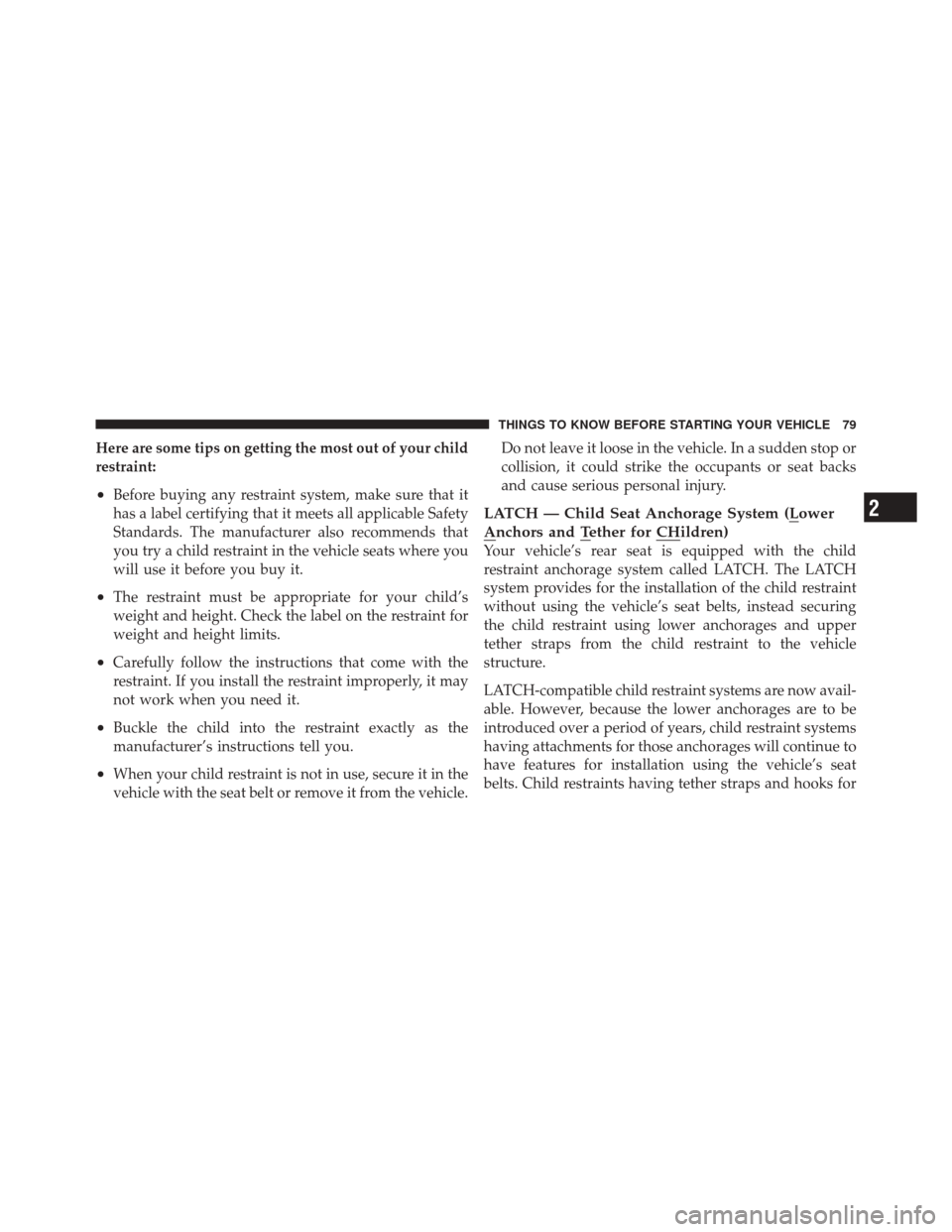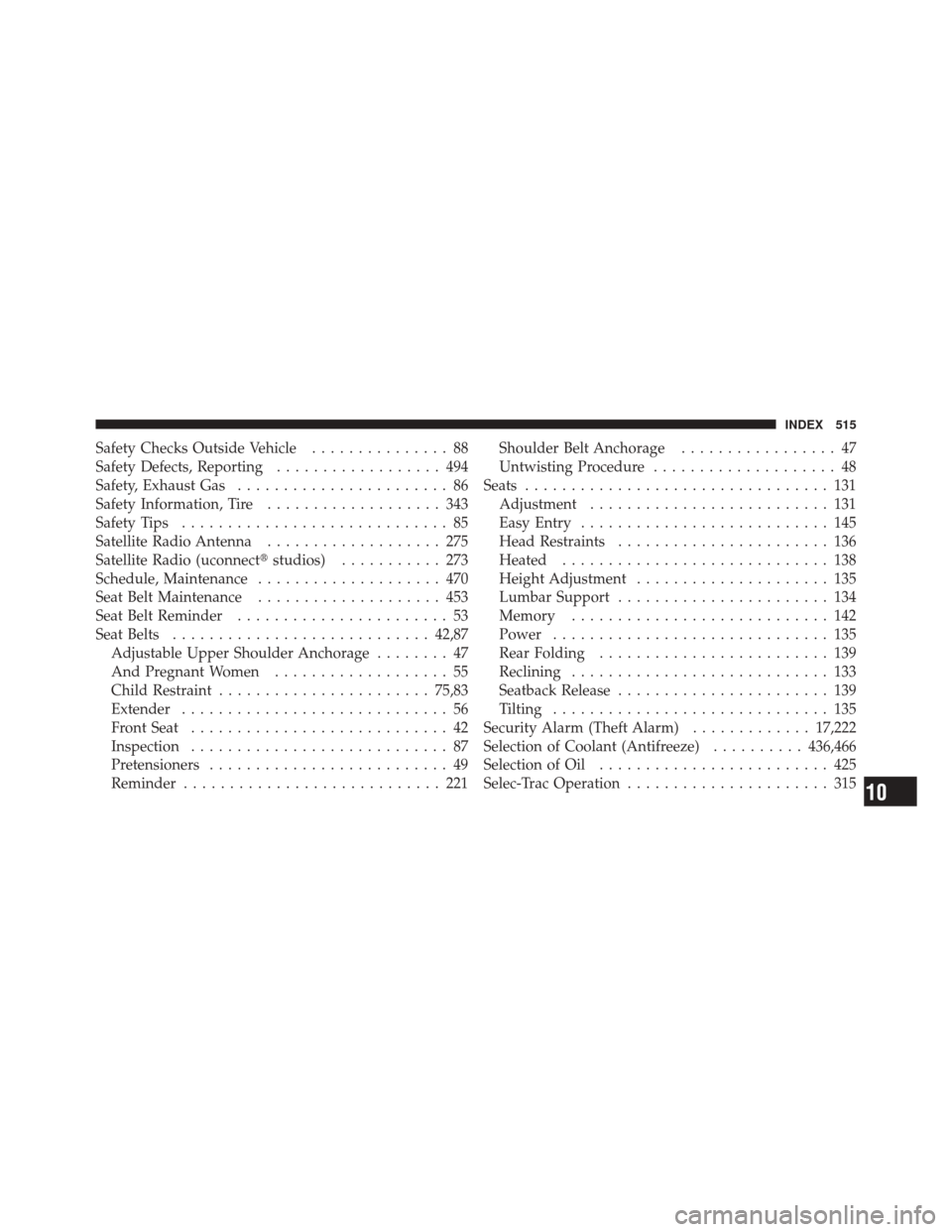Page 80 of 522

Here are some tips on getting the most out of your child
restraint:
•Before buying any restraint system, make sure that it
has a label certifying that it meets all applicable Safety
Standards. The manufacturer also recommends that
you try a child restraint in the vehicle seats where you
will use it before you buy it.
•The restraint must be appropriate for your child’s
weight and height. Check the label on the restraint for
weight and height limits.
•Carefully follow the instructions that come with the
restraint. If you install the restraint improperly, it may
not work when you need it.
•Buckle the child into the restraint exactly as the
manufacturer’s instructions tell you.
•When your child restraint is not in use, secure it in the
vehicle with the seat belt or remove it from the vehicle.Do not leave it loose in the vehicle. In a sudden stop or
collision, it could strike the occupants or seat backs
and cause serious personal injury.
LATCH — Child Seat Anchorage System (Lower
Anchors and Tether for CHildren)
Your vehicle’s rear seat is equipped with the child
restraint anchorage system called LATCH. The LATCH
system provides for the installation of the child restraint
without using the vehicle’s seat belts, instead securing
the child restraint using lower anchorages and upper
tether straps from the child restraint to the vehicle
structure.
LATCH-compatible child restraint systems are now avail-
able. However, because the lower anchorages are to be
introduced over a period of years, child restraint systems
having attachments for those anchorages will continue to
have features for installation using the vehicle’s seat
belts. Child restraints having tether straps and hooks for
2
THINGS TO KNOW BEFORE STARTING YOUR VEHICLE 79
Page 346 of 522
Tire Sizing Chart
EXAMPLE:
Size Designation:
P= Passenger car tire size based on U.S. design standards
\b....blank....\b = Passenger car tire based on European design standards
LT = Light truck tire based on U.S. design standards
T = Temporary spare tire
31 = Overall diameter in inches (in)
215 = Section width in millimeters (mm)
65 = Aspect ratio in percent (%)
— Ratio of section height to section width of tire
10.5 = Section width in inches (in)
R = Construction code
—�R� means radial construction
—�D� means diagonal or bias construction
15 = Rim diameter in inches (in)
5
STARTING AND OPERATING 345
Page 385 of 522

Frontal Area
The frontal area is the maximum height and maximum
width of the front of a trailer.
Trailer Sway Control — Mechanical
The trailer sway control is a telescoping link that can be
installed between the hitch receiver and the trailer tongue
that typically provides adjustable friction associated with
the telescoping motion to dampen any unwanted trailer
swaying motions while traveling.
Weight-Carrying Hitch
A weight-carrying hitch supports the trailer tongue
weight, just as if it were luggage located at a hitch ball or
some other connecting point of the vehicle. These kinds
of hitches are the most popular on the market today and
they are commonly used to tow small- and medium-
sized trailers.
Weight-Distributing Hitch
A weight-distributing system works by applying lever-
age through spring (load) bars. They are typically used
for heavier loads, to distribute trailer tongue weight to
the tow vehicle’s front axle and the trailer axle(s). When
used in accordance with the manufacturers’ directions, it
provides for a more level ride, offering more consistent
steering and brake control thereby enhancing towing
safety. The addition of a friction/hydraulic sway control
also dampens sway caused by traffic and crosswinds and
contributes positively to tow vehicle and trailer stability.
Trailer sway control and a weight distributing (load
equalizing) hitch are recommended for heavier Tongue
Weights (TW) and may be required depending on Vehicle
and Trailer configuration/loading to comply with Gross
Axle Weight Rating (GAWR) requirements.
384 STARTING AND OPERATING
Page 516 of 522

Safety Checks Outside Vehicle............... 88
Safety Defects, Reporting .................. 494
Safety, Exhaust Gas ....................... 86
Safety Information, Tire ................... 343
Safety Tips ............................. 85
Satellite Radio Antenna ................... 275
Satellite Radio (uconnect� studios)........... 273
Schedule, Maintenance .................... 470
Seat Belt Maintenance .................... 453
Seat Belt Reminder ....................... 53
Seat Belts ............................ 42,87
Adjustable Upper Shoulder Anchorage ........ 47
And Pregnant Women ................... 55
Child Restraint ....................... 75,83
Extender ............................. 56
Front Seat ............................ 42
Inspection ............................ 87
Pretensioners .......................... 49
Reminder ............................ 221 Shoulder Belt Anchorage
................. 47
Untwisting Procedure .................... 48
Seats ................................. 131
Adjustment .......................... 131
Easy Entry ........................... 145
Head Restraints ....................... 136
Heated ............................. 138
Height Adjustment ..................... 135
Lumbar Support ....................... 134
Memory ............................ 142
Power .............................. 135
Rear Folding ......................... 139
Reclining ............................ 133
Seatback Release ....................... 139
Tilting .............................. 135
Security Alarm (Theft Alarm) .............17,222
Selection of Coolant (Antifreeze) ..........436,466
Selection of Oil ......................... 425
Selec-Trac Operation ...................... 315
10
INDEX 515